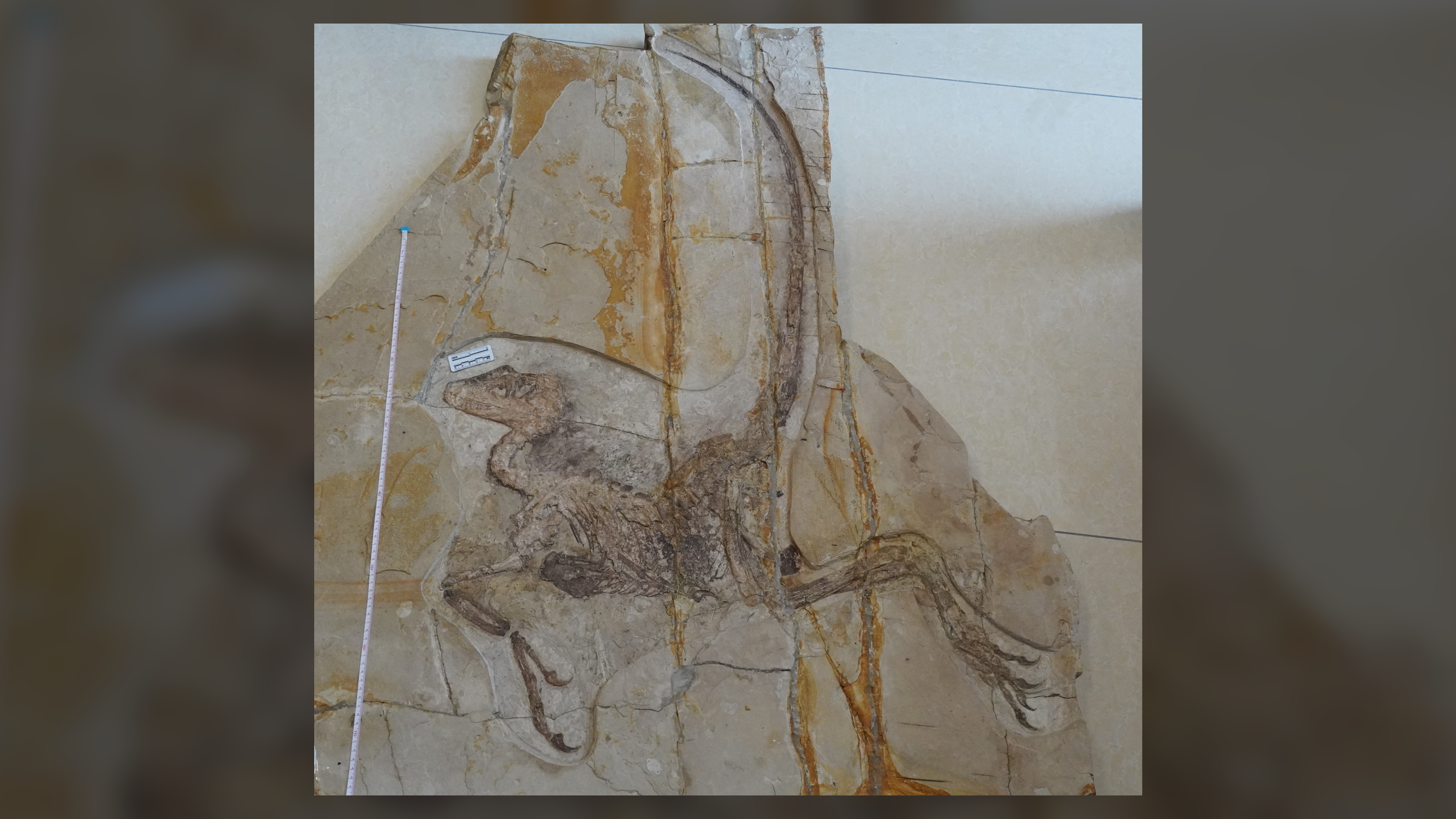Ravenous meat-eating dinosaur's guts preserved in exceptionally rare fossil
Paleontologists in China have examined the remarkable gut remnants of a birdlike dinosaur that lived more than 100 million years ago.

More than 100 million years ago, a fearsome birdlike dinosaur was swept into a lake and transformed into an exceptional fossil in what is now China, preserving one of the few intact gut remnants known from nonavian dinosaurs, a new study finds.
Paleontologists knew they had unearthed something special when they saw "a large bluish layer in the abdomen'' of the fossilized beast, which belongs to the newly discovered species Daurlong wangi, as well as a dinosaur lineage called the dromaeosaurids, which includes the ancestors of modern birds. This bluish layer had "exceptional preservation" of the dinosaur's gut, the researchers wrote in the study, published in the journal Scientific Reports on Nov. 19.
The finding offers valuable insight into both bird and dinosaur gut evolution, giving researchers a clearer window into dinnertime during the Lower Cretaceous (145 million to 100.5 million years ago).
Related: These 125 million-year-old fossils may hold dinosaur DNA
Dromaeosaurids — also known as "raptors" — like D. wangi were mostly small, feathered and carnivorous. This group roamed the Earth from the mid-Jurassic period (about 167 million years ago) until the end of the Cretaceous period (66 million years ago). Their ranks included some of the most famous pop culture dinosaurs, such as Velociraptor and Deinonychus. But despite their popularity, little is known about their actual guts.
Soft tissue preservation is rare for any fossil, and intestinal preservation is particularly uncommon in dinosaurs. "This is the first case among dromaeosaurids," study co-author Andrea Cau, an independent paleontologist based in Parma, Italy, told Live Science in an email.
Fossilization conditions have to be just right in order to prevent decay-causing bacteria from eating away delicate soft tissues, such as cartilage and organs. The newly described D. wangi specimen was likely buried very quickly under soft, fine sediments at the bottom of a body of water in what is now the Jehol Biota — an area known for well-preserved fossils in modern-day Inner Mongolia, an autonomous region in northern China. There, in the low-oxygen environment where aerobic bacteria could not survive, the dinosaur's remains mineralized into fossils.
Sign up for the Live Science daily newsletter now
Get the world’s most fascinating discoveries delivered straight to your inbox.
The researchers named the dinosaur's genus, "Daurlong," after the Daur people of Inner Mongolia and "long," the Chinese word for "dragon." The species name, "wangi," honors Wang Junyou, the director of the Inner Mongolian Museum of Natural History.
The remarkable preservation provides insight into how D. wangi lived, and what it could have eaten. From what the researchers could tell, its intestinal tract appears similar to the very few other remnants known from meat-eating dinosaurs, suggesting that more omnivorous dromaeosaurid gut plans didn't evolve until after the dawn of modern birds following the Cretaceous period. It also appears that D. wangi ate small prey, such as mammals (which were no larger than badgers during the Mesozoic era), fish, other small dinosaurs and possibly amphibians. "Given the abundance of frogs and other amphibians in the Daurlong locality," it's possible that this dromaeosaurid hunted frogs and salamanders, Cau said.
Although D. wangi's guts were preserved, its stomach was not. Perhaps the "extremely acid environment of the stomach immediately after the death of the animal" prevented it from mineralizing and turning into a fossil, the researchers wrote in the study.
Contrary to their depiction in the 1993 movie "Jurassic Park," most dromaeosaurids were relatively small and lightweight. D. wangi itself was a little less than five feet (1.5 meters) long from tip to tail, about the size of a pony. And, like other members of its family, it sported feathers.
In the future, Cau and his team plan to examine the specimen more closely to glean insight about its feathers, life, and possibly its death. "Our hope is to determine some information about its plumage color in life and to better reconstruct the peculiar conditions which led to soft tissue preservation," he said.

Joanna Thompson is a science journalist and runner based in New York. She holds a B.S. in Zoology and a B.A. in Creative Writing from North Carolina State University, as well as a Master's in Science Journalism from NYU's Science, Health and Environmental Reporting Program. Find more of her work in Scientific American, The Daily Beast, Atlas Obscura or Audubon Magazine.










